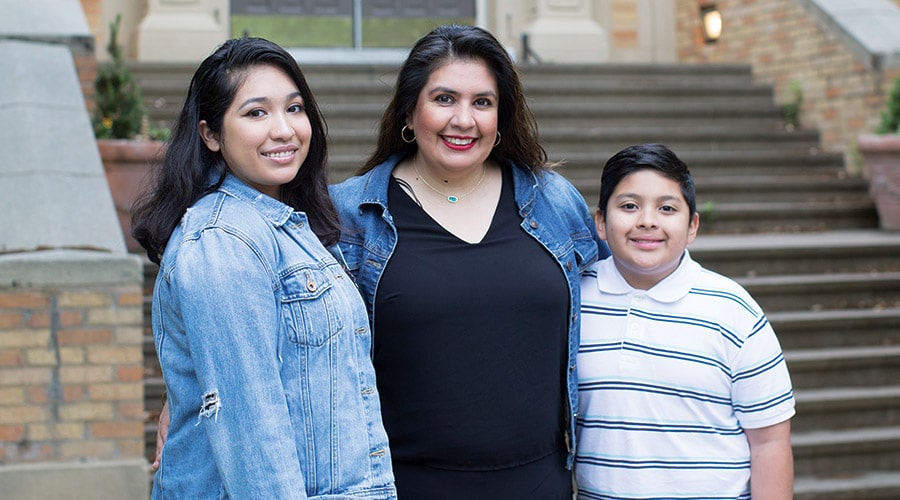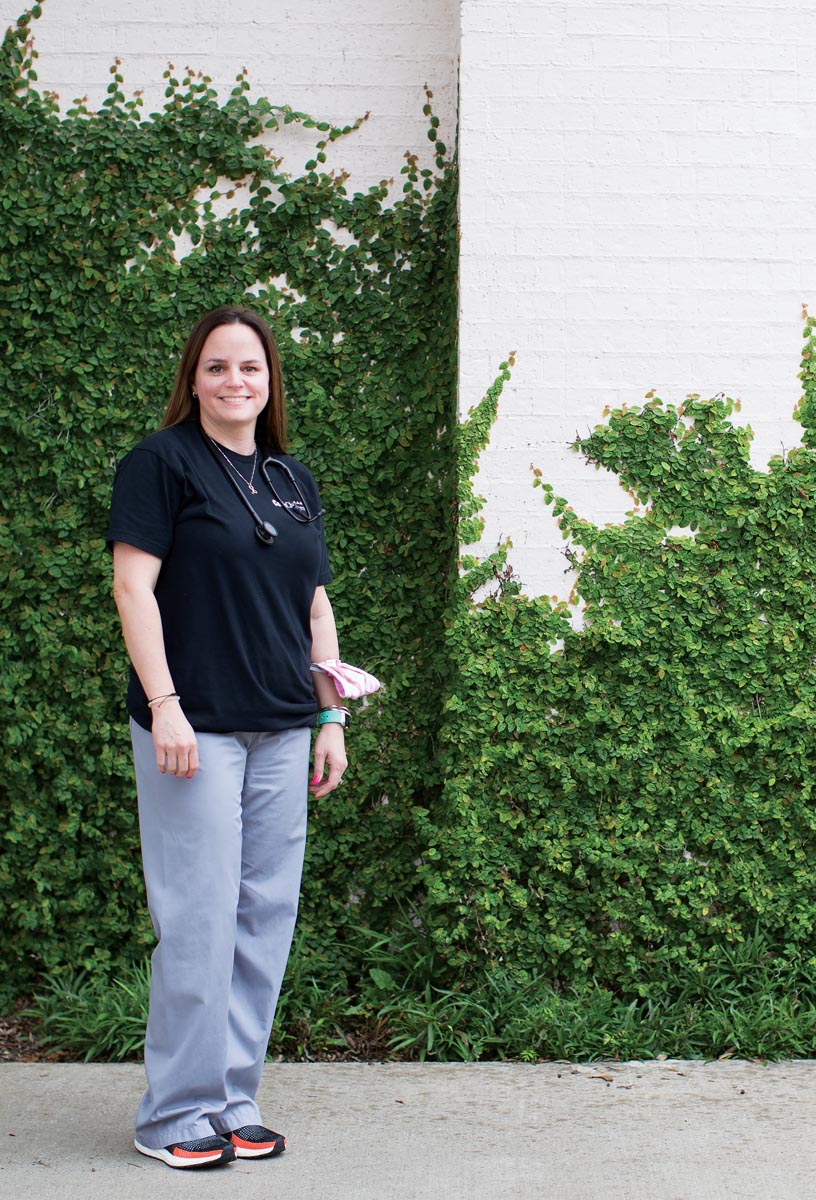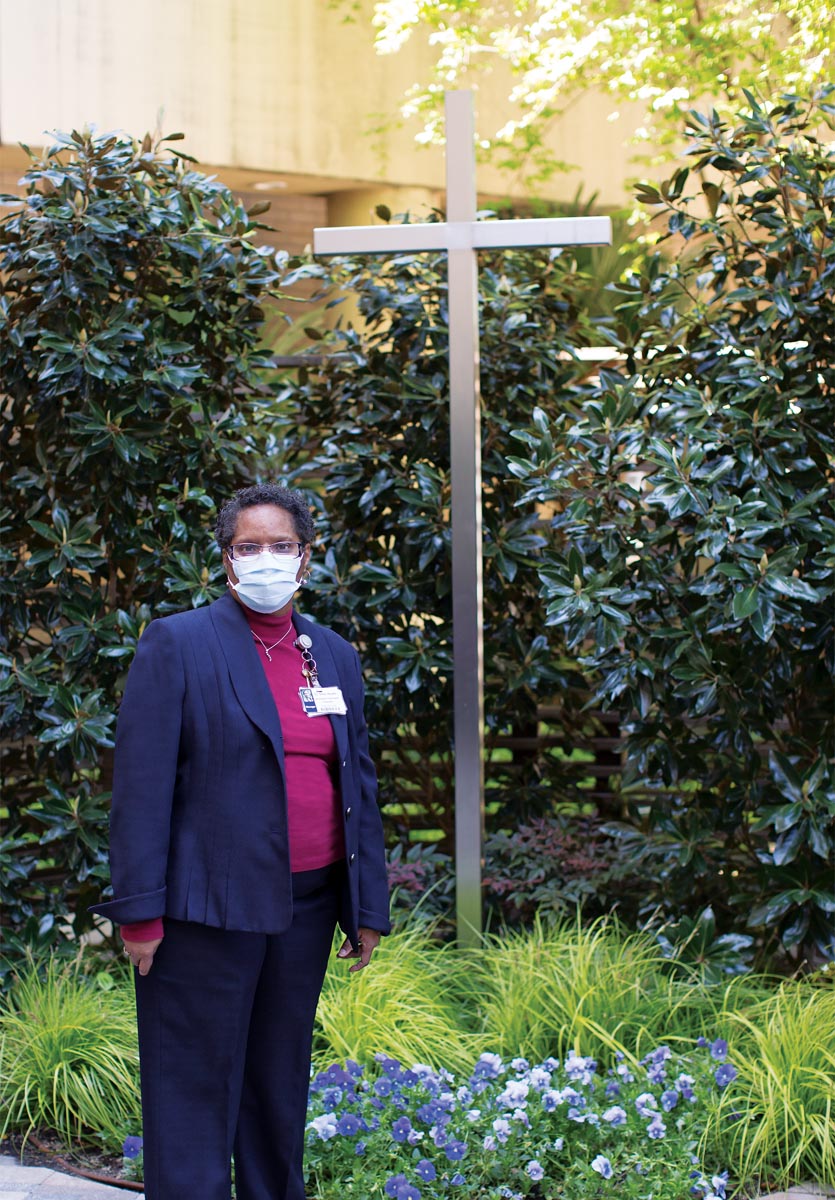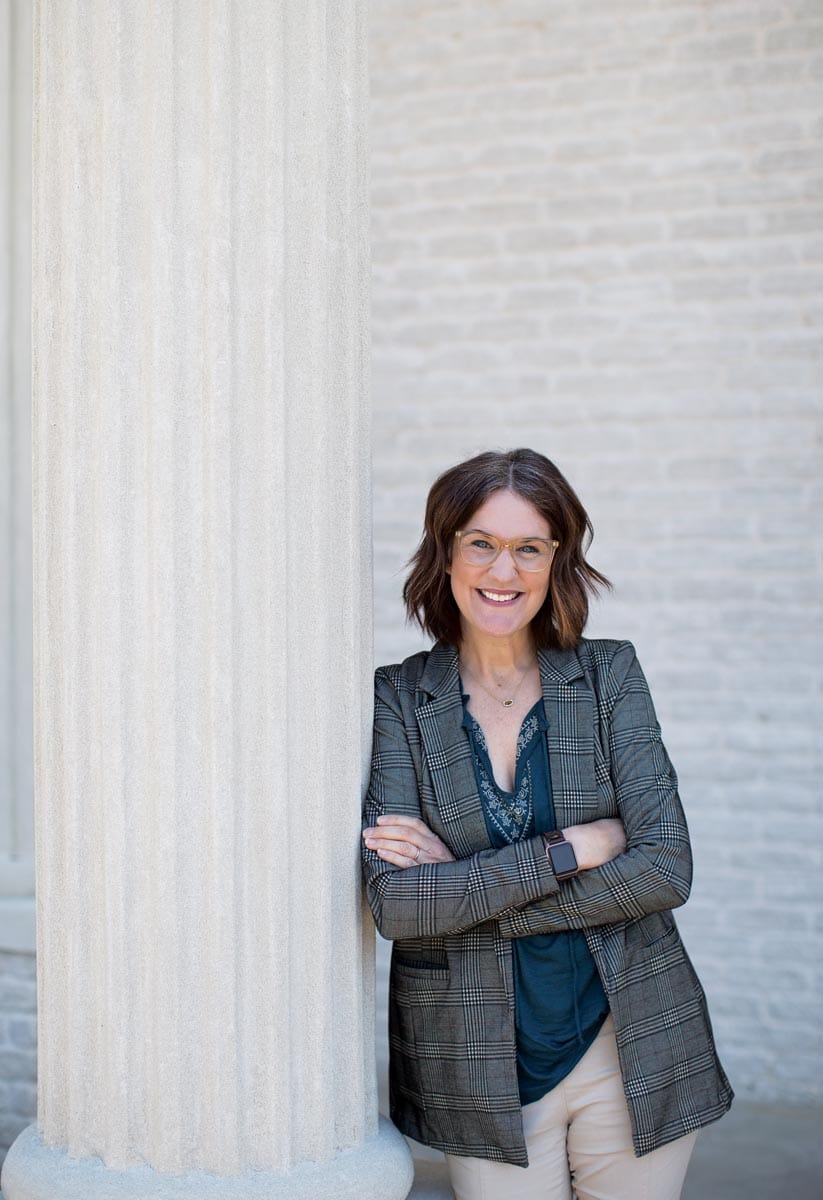
The Helpers
Photos by Ron Jenkins
The nurse
A good night in the ER is a quiet one, but for Michelle Hudson being prepared for whatever happens defines the job she loves. By Meda Kessler
Michelle Hudson’s 12½-hour overnight shifts have felt longer these past months.
As a charge nurse in the emergency room at Cook Children’s Medical Center, daily changes in protocols, policies and procedures have been a norm due to COVID-19. Cook’s staff started preparing for coronavirus patients in February and saw their first ER admittance in March (the 18-year-old was discharged in early April).
Michelle also has sensed an overall mood change at the hospital, and the ER actually has been quieter because of the pandemic. “On a normal day, we can see up 325 to 370 patients in one 24-hour period.” But the ER staff did deal with more outdoor- and home-related injuries after the shelter-in-place recommendations took place. That includes an increase in child-abuse cases over a month’s period, including three deaths — one a 3-year-old who died early on Easter morning.
Despite the dangers and heartache, the 44-year-old says she wouldn’t want to be anywhere else. “We are a team, and there’s nowhere else I’d rather be than here. You plan for the worst and hope for a quiet night. We cope by talking to each other, and that includes our EMTs. Or I’ll reach out to the chaplain for some guidance.”
It was a medical emergency that drew Michelle into nursing. Her daughter Samantha, now 20, was born with a condition that kept her in the hospital for 50 days. She saw for herself what compassionate patient care does for the family as well as the patient. Michelle got a job at Cook’s while in nursing school and has been working the night shift since 2004.
Husband Brad works from their Fort Worth home, and while Michelle doesn’t have much patient contact, she still takes precautions, such as leaving her shoes in the garage.
Samantha has remained at her apartment at Stephen F. Austin University in Nacogdoches, where she attends school. “She has diminished lung capacity, a result of her newborn illness, so she knows that she needs to stay home,” says Michelle. Austin, their 23-year-old son, lives in Washington state. Michelle says both have urged her to be careful, too. “They know I love what I do.”
The only baby at home is Ava, their 6-month-old Boykin spaniel. “When I get home in the morning, I stay up and play with her for an hour or so, and then I go to sleep and get up around 2 p.m.”
Like the rest of us, her days off are mostly spent at home. “On days when I feel like the world is spinning a bit faster, I find myself sleeping more.”
She also marvels at the kindness and generosity people have shown to those in the medical professions. “I go into work, and there’s food that someone has brought in for the staff.”
While dinner with her co-workers is nice, Michelle admits she really misses Friday date nights with her husband. “We’d always go out. But at least we’re able to hang out at home together. That’s pretty nice, too.”
The chaplain
Jacquetta Chambers ministers to hospital staff and patients with generous doses of daily prayer and salves of comfort. By Babs Rodriguez
Her voice, even filtered through a cellphone, fills the room with reassurance. Her tone is measured but warm. Not giving hugs or handshakes is an unfamiliar boundary for the manager of pastoral care at Texas Health Harris Methodist Hospital Hurst-Euless-Bedford. But comfort and prayer remain powerful tools in the kit of pastor Jacquetta Chambers, who has used them in recent months to build innovative bridges of contact between her staff and a flock of health care workers, patients and their families.
For 11 of the 32 years she spent as a United Methodist minister, Chambers — who has a doctorate in ministry with an emphasis on pastoral care and counseling — also worked as a hospital chaplain. Retiring from the church in 2019, she accepted the full-time managerial position at the Bedford hospital last October. Her staff includes three chaplains, plus four “as needed” employees, all in service of the spiritual needs of the
322-bed facility and its medical staff of 600.
Caretakers adapt to the times. A challenge in late March inspired an impromptu baptism. When COVID-19 closed the hospital chapel, Chambers asked the man requesting the service — he was scheduled for surgery days later — and his wife to meet her in the parking lot. She prayed as she sprinkled him with water. Tears flowed all around, too.
In ordinary times, Chambers ensures all patients see a chaplain within two to three days of admission. But now things are different. “A complication for us is that we always make a commitment to sit, to let patients know we are here to listen and to pray. And a lot of time prayer involves reaching out, making some kind of physical contact. Now, we can’t commit to sit.”
Chambers and her team now spend much of their days praying with frontline staff during shift changes, huddles and after traumatic events. They rely on nursing staff to relay word of an anxious patient and pass along reassurance that the chaplains are praying for them and also are available to their family by phone.
There are other ways of reaching out, too. “Every day at 11 a.m. and 7 p.m., we ring mindfulness chimes. They remind us to be mindful of the needs of patients, their families and our staff, and we stop and say a prayer or a blessing. We ask nursing staff to tell patients that when they hear the chimes to remember we are here thinking of them.”
She has expanded that spiritual network, too. “I was getting calls from churches wanting to know how they can help.” She answered by calling around to ask which congregations would commit to a prayer partnership for hospital staff. Each church chooses a specific time slot one day every week when their prayer warriors will concentrate on lifting up the medical workers. “We now have partners in every denomination imaginable — including an area mosque that forwarded our message all the way to Sudan.”
Chambers also focuses on ways of coping outside of work. “I meet with my pastoral staff every morning, and we take the time to talk about their lives. In my bag of useful things, I have a master of science in psychology. I have done counseling, been a counselor; I utilize that background to help,” she says. “We talk about the need to get away, turn your pager system off and try to not worry about the hospital. I do that myself. An older lady taught me about a year ago how to do some stitches. I went out and bought yards of thread, and I am still crocheting. I think of the woman who taught me often. She had cancer, but she still took the time to crochet things for others. Also, I meditate and read and do yoga stretches to center myself. Boredom is not something I suffer from.”
The social worker
Kathryn Jacob aims to keep women and children who seek shelter from domestic violence safe — and healthy. By Babs Rodriguez
Over an arc of 10 days in March, phone calls to the Tarrant County domestic violence hotline surged to more than 80 per day before dwindling to half that many. Slowly, they have returned to the usual 65 or so per day. Kathryn Jacob, president/CEO of SafeHaven of Tarrant County, says that early shift is not surprising.
“When the coronavirus looked like it was going to force people into quarantine situations, many women reached out. From the agency’s 40 years of experience with survivors of domestic abuse, we know that victims of intimate partner violence prove to be ingenious at escaping, seeking help under the radar,” she says. “Some took action as quickly as they could. Now we have to imagine many are unable to make a call for help because they are locked down with their abuser.”
When call numbers fell off, Jacob says that the severity of the violence reported increased. “Julie Evans, CEO at Alliance for Children, has said something similar. There is an overlap between child abuse and domestic violence that has intensified. Offenders need to have power and use it for control over others. Alcohol, unemployment, substance abuse and pandemics can be triggers, but they are not a cause.”
During a 36-hour pause in March due to the coronavirus, safety protocols were established for SafeHaven residents and staff — of the 165 employees, 105 work at the shelters. Otherwise, the nonprofit’s programs, including long-term housing assistance, legal help, therapy and children’s programs, have remained up and running. Women who arrive alone usually bunk with as many as three others; now, they are assigned individual rooms. Mothers and children stay together. For additional protection, the agency worked with the city of Fort Worth to secure travel trailers. “We use them as quarantine environments for families with a positive coronavirus case or if we need to quarantine someone at high risk, say from a homeless shelter, before moving them into a communal shelter.”
There are temperature checks twice a day, but everyone is free to come and go. “Many women who seek shelter are employed as nurses’ aides, caretakers and in grocery stores. They have to work. We also have to be sensitive to the fact that a lot of these survivors had been held captive, sometimes for years. We do not want to retraumatize them, but we do ask those who can stay in to do so.”
Jacob, who has worked for 20 years in the nonprofit sector, grew up in Chicago, joined the Peace Corps after college and met her husband, a volunteer from Dallas, in Turkmenistan. She has helmed SafeHaven since 2015. Currently, she is working from her Mansfield home. “I have gone in to the shelters a few times. I want staff to know how valued they are. I would never ask someone to do something I wouldn’t do myself.” Her husband works for Methodist Health System, but now is at home along with the couple’s three young children. “He understands my need to go, and he knows I am careful.”
As with other nonprofits, SafeHaven is now more than ever in need of donations, some of which have recently included masks. Innovation is the name of the game. The year’s Purple Party fundraiser, canceled due to the pandemic, was reimagined into an online event. Jacob believes public support will continue to rally.
“In a time when we are quick to praise — and rightfully so — the work of health care workers, the delivery services and grocery store workers, I don’t want domestic violence survivors or our staff to be forgotten. Due to the confidential nature of our work, what we do is almost in the shadows. Especially now, we don’t want the message of our services to get lost or the staff to be unsung. We are still here; we are still providing lifesaving services. It’s important to shine light on that.” For more information about SafeHaven’s services and mission, go to safehaventc.org.
The teacher
Yesenia Soto reaches out to her students and their parents while home schooling her own kids — and herself. By Linda Simmons
What I miss the most is hearing my name called each morning and receiving my 21 hugs,” says Yesenia Soto, a kindergarten teacher at Lily B. Clayton Elementary School in Fort Worth. She has taught for 11 years, nine of them at Lily B.
Soto was halfway through her March spring break, savoring days off spent with her own children and appreciating time for herself. On Friday, March 13, the news broke. Fort Worth school district students would not be returning to class because of the coronavirus outbreak.
“To lose my classroom so abruptly was shocking. It was my second home,” says Soto. “There are no words to express how saddened I was.”
Her first reaction was to notify parents that she would pass updates to them as they became available, ensuring them she would provide resources to assist in teaching their children at home. School officials notified teachers that they had set up a schedule for them to collect their laptops and virtual-learning materials. “It was a little surreal. We had 15 minutes to collect our belongings.”
Worried about her students, Soto made a video to let them know that she was OK and would be working on some fun activities for them, putting some of the parents more at ease. Then, the hard work began. The school district directed teachers to contact each parent to help them fill out a questionnaire determining, among other things, which students needed a tablet or a computer plus internet access at home. Soto telephoned all 21 parents.
She, too, was undergoing a learning curve to master the platforms used in a virtual classroom.
“It was a crash course for me, but my kindergarten team came together in a fierce force. We searched for programs that were free for all parents to use. We took turns learning how to use Google Classroom to come up with user-friendly activities for my parents who are Spanish- and English-speaking. We are not only working with our students, but we are also instructing their parents on how to be teachers themselves.”
And while we’ve all seen humorous social media posts about Zoom meetings, imagine how it is for the teacher listening and watching close to two dozen 6-year-olds trying to talk at once about everything — what their pets are doing, what their brothers and sisters are up to and anything else that pops up in the mind of a kindergartner.
“My main goal was to help them deal with the fear of the unknown, which we all have. “There’s a book called Ruby’s Worry that they all know. I told them they could share their own worries with me, no matter how big or small, just like in the book.”
The single mom has come to embrace her own “home school” environment. “My norm has changed. I am able to stay in my comfy clothes and do not have to commute to school. But I also must care for my own two children to make sure they are doing their studies. I still have to go out for groceries and cook, all while responding in a timely manner to emails and texts.” The positives revolve around her children, getting to share stories and play board games with them.
“I hope that this time period will be one my children will recall with fond memories, time we might not have had together if we had been in the classroom.”
Despite the positives, Soto misses her days at school. She says virtual learning does not allow her to enjoy a student’s delight when a new concept is grasped or relish a smile when a new word has been added to a child’s vocabulary. And it saddens her not to be able to say goodbye to each of her students as the school year ends. “I can’t wait to see them next year.”




